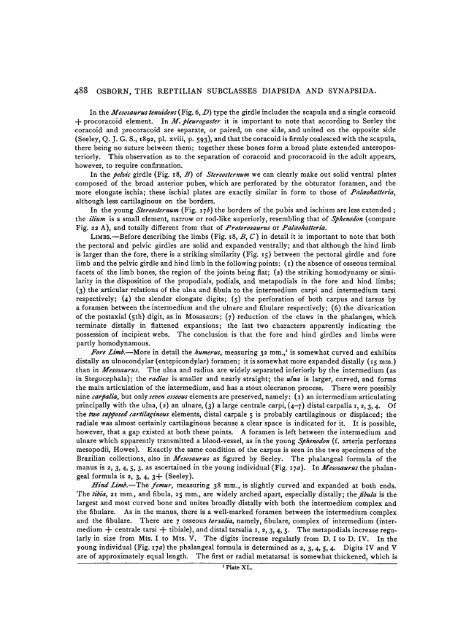American Museum of Natural History
American Museum of Natural History
American Museum of Natural History
Create successful ePaper yourself
Turn your PDF publications into a flip-book with our unique Google optimized e-Paper software.
488 OSBORN, THE REPTILIAN SUBCLASSES DIAPSIDA AND SYNAPSIDA.<br />
In the Mesosaurus tenuidens (Fig. 6, D) type the girdle includes the scapula and a single coracoid<br />
+ procoracoid elemenxt. In M. pleurogaster it is important to note that according to Seeley the<br />
coracoid and procoracoid are separate, or paired, on one side, and united on the opposite side<br />
(Seeley, Q. J. G. S., 1892, pI. xviii, p. 593), and that the coracoid is firmly coalesced with the scapula,<br />
there being no suture between them; together these bones form a broad plate extended anteroposteriorly.<br />
This observation as to the separation <strong>of</strong> coracoid and procoracoid in the adult appears,<br />
however, to require confirmation.<br />
In the pelvic girdle (Fig. I8, B) <strong>of</strong> Stereosternum we can clearly make out solid ventral plates<br />
composed <strong>of</strong> the broad anterior pubes, which are perforated by the obturator foramen, and the<br />
more elongate ischia; these ischial plates are exactly similar in form to those <strong>of</strong> Paleohatteria,<br />
although less cartilaginous on the borders.<br />
In the young Stereosternum (Fig. 17b) the borders <strong>of</strong> the pubis and ischium are less extended;<br />
the ilium is a small element, narrow or rod-like superiorly, resembling that <strong>of</strong> Sphenodon (compare<br />
Fig. 22 A), and totally different from that <strong>of</strong> Protorosaurus or Palcohatteria.<br />
LIMBS.-Before describing the limbs (Fig. i8, B, C) in detail it is important to note that both<br />
the pectoral and pelvic girdles are solid and expanded ventrally; and that although the hind limb<br />
is larger than the fore, there is a striking similarity (Fig. 15) between the pectoral girdle and fore<br />
limb and the pelvic girdle and hind limb in the following points: (i) the absence <strong>of</strong> osseous terminal<br />
facets <strong>of</strong> the limb bones, the region <strong>of</strong> the joints being flat; (2) the striking homodynamy or similarity<br />
in the disposition <strong>of</strong> the propodials, podials, and metapodials in the fore and hind limbs;<br />
(3) the articular relations <strong>of</strong> the ulna and fibula to the intermedium carpi and intermedium tarsi<br />
respectively; (4) the slender elongate digits; (5) the perforation <strong>of</strong> both carpus and tarsus by<br />
a foramen between the intermedium and the ulnare and fibulare respectively; (6) the divarication<br />
<strong>of</strong> the postaxial (5th) digit, as in Mosasaurs; (7) reduction <strong>of</strong> the claws in the phalanges, which<br />
terminate distally in flattened expansions; the last two characters apparently indicating the<br />
possession <strong>of</strong> incipient webs. The conclusion is that the fore and hind girdles and limbs were<br />
partly homodynamous.<br />
Fore Limb.-More in detail the humerus, measuring 32 mm.,' is somewhat curved and exhibits<br />
distally an ulnocondylar (entepicondylar) foramen; it is somewhat more expanded distally (I5 mm.)<br />
than in Mesosaurus. The ulna and radius are widely separated inferiorly by the intermedium (as<br />
in Stegocephala); the radius is smaller and nearly straight; the ulna is larger, curved, and forms<br />
the main articulation <strong>of</strong> the intermedium, and has a stout olecranon process. There were possibly<br />
nine carpalia, but only seven osseous elements are preserved, namely: (i) an intermedium articulating<br />
principally with the ulna, (2) an ulnare, (3) a large centrale carpi, (4-7) distal carpalia I, 2, 3, 4. Of<br />
the two supposed cartilaginous elements, distal carpale 5 is probably cartilaginous or displaced; the<br />
radiale was almost certainly cartilaginous because a clear space is indicated for it. It i-s possible,<br />
however, that a gap existed at both these points. A foramen is left between the intermedium and<br />
ulnare which apparently transmitted a blood-vessel, as in the young Sphenodon (f. arteria perforans<br />
mesopodii, Howes). Exactly the same condition <strong>of</strong> the carpus is seen in the two specimens <strong>of</strong> the<br />
Brazilian collections, also in Mesosaurrus as figured by Seeley. The phalangeal formula <strong>of</strong> the<br />
manus is 2, 3, 4, 5, 3, as ascertained in the young individual (Fig. 17a). In Mesosaurus the phalangeal<br />
formula is 2, 3, 4, 3+ (Seeley).<br />
Hind Limb.-The femur, measuring 38 mm., is slightly curved and expanded at both ends.<br />
The tibia, 21 mm., and fibula, 25 mm., are widely arched apart, especially distally; thefibula is the<br />
largest and most curved bone and unites broadly distally with both the intermedium complex and<br />
the fibulare. As in the manus, there is a well-marked foramen between the intermedium complex<br />
and the fibulare. There are 7 osseous tarsalia, namely, fibulare, complex <strong>of</strong> intermedium (intermedium<br />
+ centrale tarsi + tibiale), and distal tarsalia I, 2, 3, 4, 5. The metapodials increase regularly<br />
in size from Mts. I to Mts. V. The digits increase regularly from D. I to D. IV. In the<br />
young individual (Fig. I7a) the phalangeal formula is determined as 2, 3, 4, 5, 4. Digits IV and V<br />
are <strong>of</strong> approximately equal length. The first or radial metatarsal is somewhat thickened, which is<br />
I Plate XL.

















